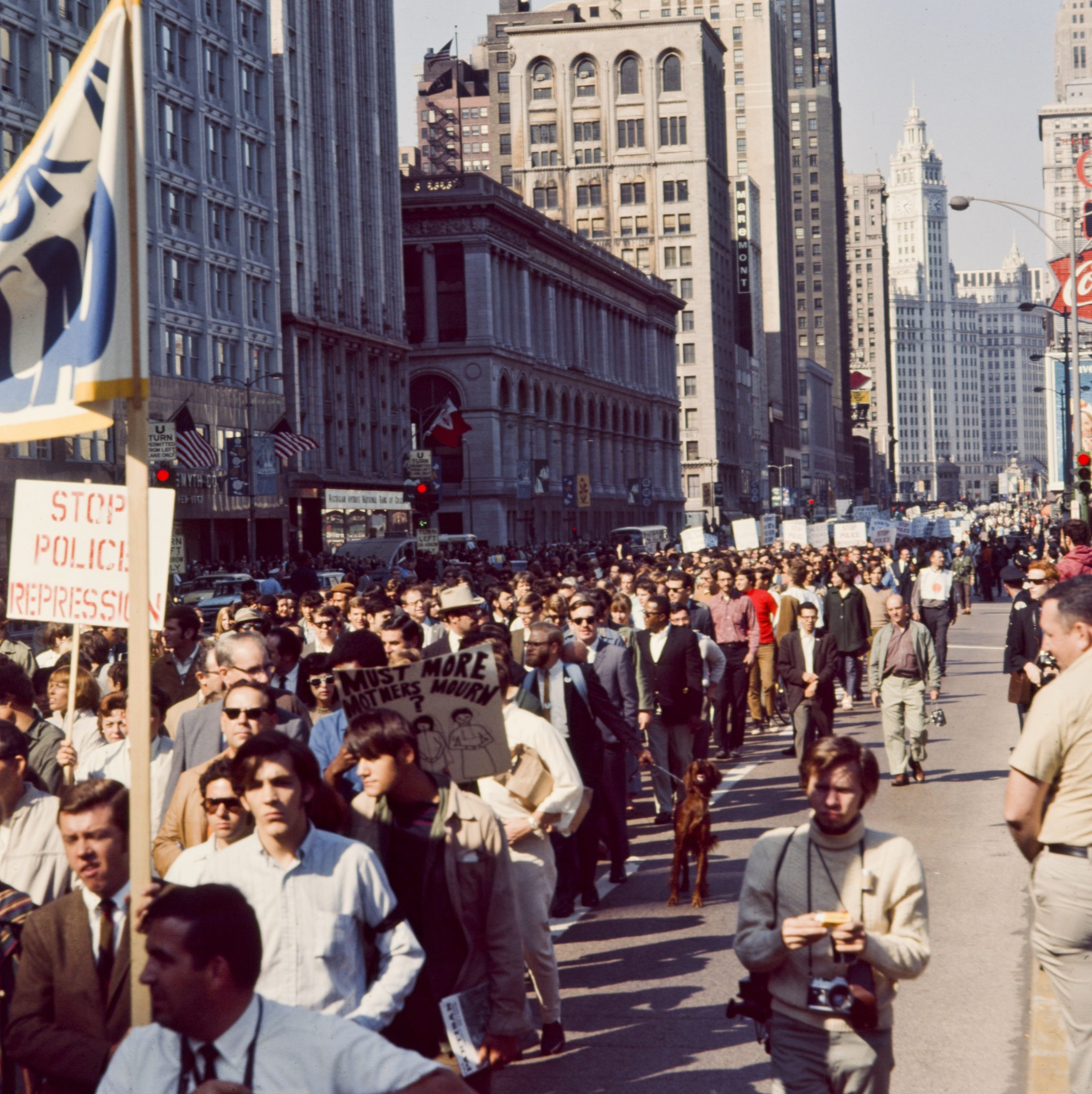September 24, 1969, marked the beginning of one of the most infamous trials in U.S. history for eight (later seven) activists linked to the protests that took place in response to the 1968 Democratic National Convention, held in Chicago at the International Amphitheatre on August 26‒29.
Eight defendants, Rennie Davis, David Dellinger, John Froines, Tom Hayden, Abbie Hoffman, Jerry Rubin, Lee Weiner, and Bobby Seale, were charged by the federal government with several accusations that included conspiracy and crossing state lines to incite riots.

Profile view of all the Chicago Seven Trial defendants, 1969‒70. CHM, ICHi-051727; Franklin McMahon, artist
In the summer of 1968, more than 10,000 people came to Chicago ready to protest the wildly unpopular Vietnam War, which had been raging for over a decade. The protest was originally planned to be a nonviolent gathering at Lincoln Park. But it expanded over multiple days to street protests and demonstrations in Grant Park, which quickly turned chaotic when protestors were met by leagues of uniformed CPD and National Guard officers, armed with antiriot equipment and tasked to maintain order. The chaos culminated on August 28, which came to be known as the “Battle of Michigan Avenue.”

View of protesters at the 1968 Democratic National Convention, marching down Michigan Avenue, 1968. CHM, ICHi-093520; Stephen Deutch, photographer
An extensive government investigation followed the unrest, and ultimately, a year later, charges against the “Conspiracy 8” would be filed, as the federal government sought to make an example of these protestors and to test the federal antiriot law passed in 1968, which made it illegal to cross state lines to incite a riot. The eight men charged were not chosen at random. Each one had a history of organizing against the war in one way or another, with the most prominent defendant being Bobby Seale, a cofounder of the Black Panther Party. During the trial, Judge Julius Hoffman ordered him to be restrained, bound, and gagged to his chair after he requested to represent himself. Not long after, Seale was removed from the case, and had a separate trial, turning the “Conspiracy 8” into the “Chicago 7.”

Bobby Seale telling Judge Julius Hoffman how it felt to be bound and gagged at Chicago Eight Trial, November 3, 1969. CHM, ICHi-051750; Franklin McMahon, artist
The jury for the Chicago 7 was composed of two white men and ten women, two of whom were Black, and the rest white. The demeanor of the defendants, especially that of Abby Hoffman was anything but formal, with vibrant attire, including leisure wear, and colorful language peppered throughout the trial, which was recorded by reporters and courtroom sketchers, as cameras were not allowed inside.

Abbie Hoffman reading a magazine at the Chicago Seven Trial, 1969‒70. CHM, ICHi-051213; Franklin McMahon, artist
Beyond being a legal case, the trial of the Chicago 7 was a cultural moment in the 1960s, where generational ideals were clashing in the public eye. The seven defendants represented a generation of activists, who were suspicious and unsupportive of a foreign war, and a judge and legal system that embodied what younger Americans perceived to be a status quo that had gone unchallenged and unchecked for far too long.

Arlo Guthrie telling story of Alice’s Restaurant to Judge Julius Hoffman at Chicago Seven Trial, 1969‒70. CHM, ICHi-051733; Franklin McMahon, artist
Ultimately, all seven defendants were acquitted of conspiracy charges, but five of the seven were charged with crossing state lines to incite riots and were convicted with five-year prison sentences and hefty fines. (Seale had also received a four-year sentence in his own trial.) A couple years later, all the convictions would be tossed by an appellate court, recognizing Judge Hoffman’s disdain for the defendants. The story of the Chicago 7 was serialized by Netflix in 2020 and continues to be one of the most important courtroom sagas in Chicago and U.S. history.
In addition to having the trial papers and notes from Judge Hoffman in our collection, in 2007, CHM acquired 483 courtroom sketches from the trial by famed news artist Franklin McMahon.
Further Resources
- See more of Franklin McMahon’s courtroom sketches
- See more images of the 1968 Democratic National Convention
- Studs Terkel’s 1968 Interview with Hoffman, Seale, and Dellinger
- I WAS THERE: The 1968 Democratic National Convention Oral History Project
- Chicago ØØ: The 1968 DNC Protests, a virtual reality experience
- Chicago: Law and Disorder Google Arts & Culture Story
- “The Park is Ours” by Brian Mullgardt in Chicago History
- The Trial of The Chicago 7: The Official Transcript